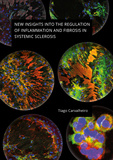New insights into the regulation of inflammation and fibrosis in systemic sclerosis

Ferreira Carvalheiro, Tiago
- Promoter:
- Prof.dr T.R.D.J. (Tim) Radstake & prof.dr L. (Linde) Meyaard
- Co-promoter:
- Dr W.K. (Wioleta) Marut & dr S. (Samuel) Garcia Pérez
- Research group:
- Inhibitory receptor lab , Radstake
- Date:
- February 22, 2022
- Time:
- 14:15 h
Summary
Systemic sclerosis (SSc) is an autoimmune rheumatic disease characterized by vasculopathy, inflammation and fibrosis of the skin and internal organs. The aetiology of SSc is largely unknown, and its pathogenesis is complex and remains poorly understood.
In this thesis we investigated several mechanisms that regulate the inflammatory and fibrotic processes in patients with SSc.
The studies presented in this thesis demonstrate several key dysregulated mechanisms that contribute for both inflammation and fibrosis on going in patients with SSc. The low expression of the transcription factor of RUNX3 alters dendritic cell function in patients with SSc and contributes to enhanced fibrosis; Angiopoietin 2 is increased in SSc patients and induces a pro-inflammatory response in monocytes; the CXCL4 chemokine drives fibrosis through multiple cell types; Semaphorin 4A levels are increased in SSc patients and activates T helper cells and contributes to the inflammatory and fibrotic phenotype of fibroblasts from SSc patients; the matricellular protein SPARC induces a pro-fibrotic phenotype in dermal fibroblasts from SSc patients, through the TGFβ signalling; the immune inhibitory receptor LAIR-1 is upregulated in inflammatory conditions and upon activation regulates cytokine production; in immune cells from SSc patients LAIR-1 is functional, however the fibrotic collagen products ineffectively activate LAIR-1, compromising its inhibitory function.
Overall, our studies provide novel potential therapeutic targets, offering new opportunities for SSc patients, but we also demonstrate the heterogeneous mechanisms involved in the SSc pathophysiology, indicating the need for a better biological characterization of the disease and an ultimate need for personalized medicine.